![]()
![]()
![]()
Use LEFT and RIGHT arrow keys to navigate between flashcards;
Use UP and DOWN arrow keys to flip the card;
H to show hint;
A reads text to speech;
33 Cards in this Set
- Front
- Back
|
5 functions of lipids |
1. Energy source 2. Membrane components 3. Storage 4. Regulatory functions (white adipose - steroids, eicosanoids, cytokines, hormones) 5. Thermogenesis (brown adipose - mediated by thermogenin/UCP) |
|
|
What happens to polyunsaturated fats when they are fed to ruminants? |
The majority are converted to saturated fats. |
|
|
What happens to lipids in the rumen? |
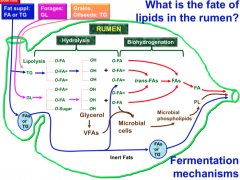
- Broken down via hydrolysis into their components (fatty acids/sugar plus a glycerol) - The FAs are biohydrogenated by microbes - Glycerol fermented by microbes to make VFAs, eventually encorporated (along with fatty acids) as phospolipids - Some fat or FAs bypasses rumen |
|
|
How does biohydrogenation work in the rumen? |
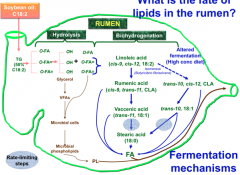
- Linoleic acid (18:2) is converted to rumenic acid (CLA) by isomerase and then to vaccenic acid (trans 18:1) and finally stearic acid (18:0) - During altered fermentation (ie high grain), linoleic acid may get converted to a different CLA by isomerase |
|
|
What are the rate limiting steps of biohydrogenation? |
- From the trans 18:1 to stearic acid (IE vaccenic acid, or the equivalent in the altered fermentation pathway)
|
|
|
What kind of fat sources are protected in the rumen? |
Calcium salt fatty acids |
|
|
What microbes help with fat hydrolysis in the rumen? |
- A. lypolytica bacteria - Protozoal lipase, galactosidase, phospholipase - Microbes also ferment glycerol |
|
|
What happens to long chain fatty acids in the rumen? |
- Not a major source of energy for microbes (toxic) - Some microbial synthesis (incorporation in structure/cytosol) - But mostly SFAs, a few MUFAs, no PUFAs
|
|
|
Is duodenal flow of FAs greater or less than FA intake? |
It is greater, because the microbes can synthesize more FAs. - Microbes can synthesize new SFAs from acetate and glucose - Or straight chain odd carbon FAs from propionate and valate |
|
|
General overview of lipid digestion and absorption |
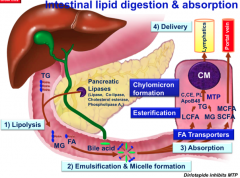
- Lypolysis by enzymes - Bile acids emulsify FAs and MGs - micelle formationa - Absorbed into the cell, where everything is re-esterified to form TGs in chylomicrons - MTP (microsomal TG transfer protein) helps assemble apo-B48 which is needed on chylomicrons - Chylomicrons enter lymph via exocytosis, which eventually get to circulation via thoracic duct (bypassing liver for now) - SCFAs and MCFAs can just go to portal circulation directly (less than 12C) |
|
|
What are chylomicrons made of? |
Core: nonpolar lipids (TGs), cholesterol ester Surface: proteins and polar lipids (phospholipids), free cholesterol |
|
|
4 causes of steatorrhea |
Steathorrhea: excess fat in feces
1. Bile salt deficiency (due to liver disease, bile duct obstruction, disrupted enterohepatic bile salt recycling, bacterial overgrowth which converts bile salts to bile acids)
2. Pancreatic enzyme deficiency (due to pancreatitis, duct obstruction, gastric hyperacidity)
3. Defective chylomicron synthesis
4. Lymphatic obstruction |
|
|
What happens to the chylomicron after it leaves the intestine? |
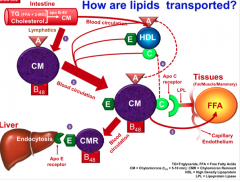
- Intestine makes chylomicrons and HDL. Both end up in circulation. - HDL donates Apo protein C to the chylomicron, making it mature, and helping it go to the tissues - The enzyme lipoprotein lipase along with an Apo C receptor can "grab" CMs. This is found on capillaries at peripheral tissues, so these tissues can use (hydrolyze) the TGs. - The chylomicron remnant is endocytosed by the liver, mediated by an Ape E receptor.
|
|
|
What happens to chylomicron remnants after they return to the liver? |
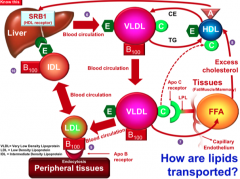
- The liver repackages TGs and cholesterol that were in the CM remnant into very low density lipoprotein (which has ApoB100) - VLDL can be hydrolyzed by peripheral tissues via the Apo C receptor and LPL enzyme (same as CM mechanism). - Now the VLDL is an LDL or IDL - IDLs and VDLs are endocytosed by the liver or peripheral tissues, mediated by Apo B100 receptors - HDL also transports cholesterol from tissues back to the liver (SRB1 receptor) |
|
|
Why are cattle especially prone to fatty liver? |
Because they have a limited capacity to export VLDL, therefore creating a bottleneck in the liver. |
|
|
General lipid metabolism chart |
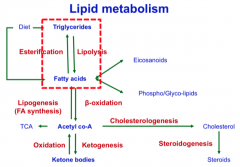
|
|
|
How are triglycerides synthesized? |

Where: liver and adipocytes (cytoplasm and smooth ER) Substrate: FAs (from denovo synthesis, diet, or TAGs) or glycerol-3-P (from glycolysis for TAGs) or dihydroxy acetone phosphate Enzyme: Glycerol-3-P Acyl Transferase |
|
|
What enzymes are involved in triglyceride break down? |
- Desnutrin (activated by glucocorticoids, inhibited by insulin) - Hormone Sensitive Lipase (activated by epinephrine and glucagon, inhibited by glucagon) - Monoglyceride Lipase
|
|
|
What happens to fatty acids in the cell? |
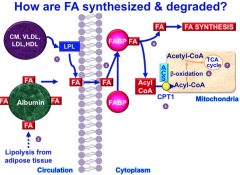
- Fatty acids enter the cell. - Fatty acids are transported by FABP (fatty acid binding protein) to their destination: either FA synthesis or beta oxidation - CPT1 controls entry to mitochondria. Once in mitochondria = beta oxidation and TCA cycle
|
|
|
Describe de novo synthesis of fatty acids in the cytoplasm. |

Substrates: - Ruminants: acetate and butyrate in adipose, glucose in muscle adipocytes - Nonruminants: Glucose
- Enzyme ACC turns Acetyl-CoA to Malonyl Co-A - Enzyme FAS uses Malonyl-CoA to make the fatty acid - More enzymes elongate the fatty acid: 2 carbons added per cycle - Enzyme desaturase can add a double bond (but not beyond C9) |
|
|
What are the rate limiting enzymes in de novo fatty acid synthesis? What inhibits or stimulates them? |
- Acetyl CoA carboxylase (ACC) - Fatty acid synthase (FAS)
Activators: insulin, citrate Inhibitors: NE, glucagon, fatty acyl CoA |
|
|
What are the primary sites of fatty acid synthesis in the different species? |
Ruminants: adipose, mammary Humans and birds: liver Rodents and rabbits: liver, adipose Dogs, cats, pigs: adipose
Secondary sites: Humans: adipose Dogs and cats: liver |
|
|
What happens in the mitochondria during beta oxidation? |
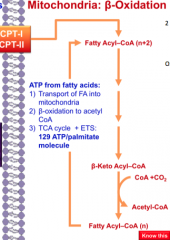
- Fatty acyl CoA (from the diet or de novo synthesis) enters the mitochondria via CPT - Beta oxidation to acetyl CoA - This repeats for every "link the the chain" - ATP is made! 129 ATP/palmitate molecule (TCA cycle and ETS) |
|
|
What is the control point for entry to the mitochondria? |
Carnitine palmitoyl transferase (CPT) and the carnitine shuttle system, which uses CPT1,CPT2 and CAT.
CPT1 is inhibited by malonyl co-A (reciprocal control mechanism) and insulin. It is stimulated by glucagon.
|
|
|
Names of the 3 lipogenesis (TAG synthesis) pathways |
1. Glycerol to phosphatidate in the liver 2. DHAP in the liver 3. MAG in the intestinal mucosa |
|
|
How does fatty acid metabolism happen in the liver? |
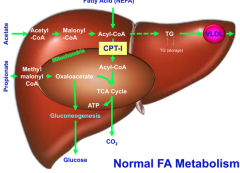
- Fatty acid synthesis: Acetate becomes acyl-coA - Acyl-CoA goes into mitochondria via CPT1 if energy is needed. (If not, they are turned into TGs and sent out as VLDL) - The Acyl-CoA goes through the TCA cycle, which requires oxaloacetate - The oxaloacetate comes from proproniate (Therefore, if there is not enough proprionate, the Acyl-CoA can't go through the TCA cycle) - Oxaloacetate can also be used to make glucose.
|
|
|
Why does ketosis happen? |

- If there is not enough oxaloacetate available to keep up with the amount of Acyl-CoA, the Acyl-CoA can't go through the TCA cycle. Instead, it becomes acetoacetate. - Acetoacetate becomes BHBA and acetone. These 3 are ketones.
- This may occur in situations where FA mobilization (alot of of NEFAs in blood) overwhelms the liver (IE negative energy balance). Common example is lactating dairy cows.
|
|
|
Where can ketones be used for energy? |
Ketones can be used as energy in the heart, muscle and brain (but not the liver, because it lacks CoA transferase). |
|
|
In cattle, what is the limiting factor of VLDL production? |
Cattle have a limited capacity to make ApoB100. This makes them especially prone to fatty liver. |
|
|
Ketone Body Oxidation diagram. What enzyme is important? |
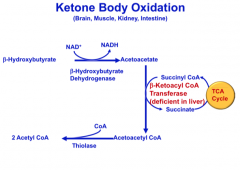
Important enzyme: Beta-ketoacyl CoA Transferase - Allows ketone to enter TCA cycle - Not in liver |
|
|
What is the rate limiting enzyme in cholesterol synthesis? |
HMG CoA reductase
(This is what cholesterol drugs target.) |
|
|
Where is cholesterol synthesized? |
- Primarily in the liver (50%) and intestine (15%) - Also in the skin, adrenal cortex, ovaries, testes and placenta |
|
|
3 Outputs of Cholesterol Metabolism (and enzymes) |
- Re-esterification (enzyme ACAT) - Biosynthesis of bile salts/steroids - Transfer to HDL (enzyme LCAT) |

